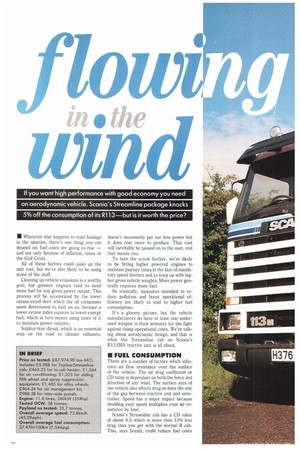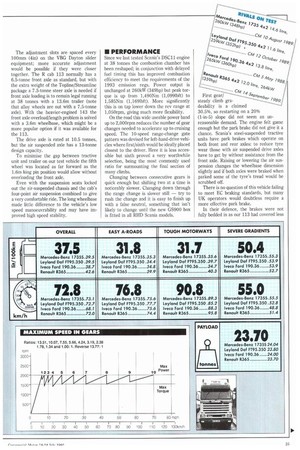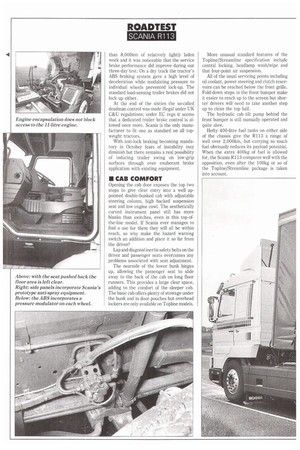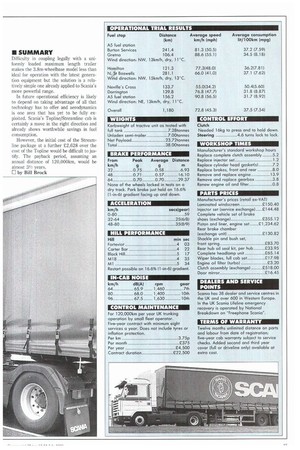• Whatever else happens to road haulage in the nineties,
Page 24

Page 26

Page 27

Page 28

Page 29

If you've noticed an error in this article please click here to report it so we can fix it.
there's one thing you can depend on: fuel costs are going to rise — and not only because of inflation, taxes or the Gulf Crisis.
All of these factors could push up the unit cost, but we're also likely to be using more of the stuff.
Cleaning up vehicle emissions is a worthy goal, but greener engines tend to need more fuel for any given power output. This process will be accelerated by the lower cetane-rated dery which the oil companies seem determined to foist on us, because a lower cetane index equates to lower energy fuel, which in turn means using more of it to maintain power outputs.
Sulphur-free diesel, which is an essential step on the road to cleaner exhausts, doesn't necessarily put out less power but it does cost more to produce. That cost will inevitably be passed on to the user, and that means you.
To turn the screw further, we're likely to be fitting higher powered engines to maintain journey times in the face of mandatory speed limiters and to keep up with higher gross vehicle weights. More power generally requires more fuel.
So ironically, measures intended to reduce pollution and boost operational efficiency are likely to lead to higher fuel consumption.
It's a gloomy picture, but the vehicle manufacturers do have 'at least one underused weapon in their armoury for the fight against rising operational costs. We're talking about aerodynamic design, and that is what the Streamline cab on Scania's R113MA tractive unit is all about.
• FUEL CONSUMPTION
There are a number of factors which influence air flow resistance over the surface of the vehicle. The air drag coefficient or CD value is dependant on both the force and direction of any wind. The surface area of the vehicle also affects drag as does the size of the gap between tractive unit and semitrailer. Speed has a major impact because doubling your speed multiplies your air resistance by four.
Scania's Streamline cab has a CD value of about 0.5 which is more than 12% less drag than you get with the normal R cab. This, says Scania, could reduce fuel costs by as much as 5% for a vehicle involved in long-haul operations.
That's no idle boast, because it's just about the fuel saving we recorded over our Scottish test route in less than ideal weather conditions, when compared with the similarly powered 6x2 R113 we tested in 1988.
In our experience the 6x2+2 axle configuration is generally about 1% more fuel efficient than an equivalent 4x2+3 combination.
Individual sections of our route highlight the Scania's consistently efficient fuel consumption, which was returned at aboveaverage speeds. And its overall result of 37.47lit/100km (7.54mpg) is the best we have achieved with a 4x2 tractive unit at this power-to-weight ratio.
• BODYWORK
Compared with the standard R cab the optional Streamline cab features larger corner radii (up to about 250mm), flush-mounted direction indicators, corner deflectors, and deeper doors which cover the step well. The front bumper is also rounded off to match the lines of the cab; side skirts enclose the sides of the tractor unit and merge into the rear mudguards and incorporate Scania's prototype anti-spray system.
Low profile tyres — now standard fitment on all Scanias except for tipper chassis — reduce overall height and assist economical running with a lower rolling resistance. Final drive ratios have been modified to avoid any change in overall gearing.
These changes may look superficial as all Scania cabs are variations of one basic design; in fact they were introduced only after 40,000 hours of development.
With a 3.8m wheelbase our test tractor is primarily designed to couple with the longer semi-trailers now permitted — although most operators seem happy to stick with 12.2m.
While the R113 can be used with trailers up to 13.4m where the load is evenly distributed, a sliding fifth-wheel helps promote legal axle load compatibility and is particularly useful when catering for uneven loading. The adjustment slots are spaced every 100mm (4in) on the VBG Dayton slider equipment; more accurate adjustment would be possible if they were closer together. The R cab 113 normally has a 6.5-tonne front axle as standard, but with the extra weight of the Topline/Streamline package a 7.5-tonne steer axle is needed if front axle loading is to remain legal running at 38 tonnes with a 13.6m trailer (note that alloy wheels are out with a 7.5-tonne axle). With the heavier-engined 143 the front axle overload/length problem is solved with a 3.6m wheelbase, which might be a more popular option if it was available for the 113.
The drive axle is rated at 10.5 tonnes, but the air suspended axle has a 13-tonne design capacity.
To minimise the gap between tractive unit and trailer on our test vehicle the fifth wheel was located as far forward as the 1.6m king pin position would allow without overloading the front axle.
Even with the suspension seats locked out the air-suspended chassis and the cab's four-point air suspension combined to give a very comfortable ride. The long wheelbase made little difference to the vehicle's low speed manoeuvrability and may have improved high speed stability.
• PERFORMANCE
Since we lasl tested Scania's DSC11 engine at 38 tonnes the combustion chamber has been reshaped; in conjunction with delayed fuel timing this has improved combustion efficiency to meet the requirements of the 1993 emission regs. Power output is unchanged at 260kW (349hp) but peak torque is up from 1,490Nm (1,099Ibft) to 1,585Nm (1,1691bft). More significantly this is on tap lower down the rev range at 1,050rpm, giving much more flexibility.
On the road this wide useable power band up to 2,000rpm reduces the number of gear changes needed to accelerate up to cruising speed. The 10-speed range-change gate pattern was devised for left-hand-drive vehicles where first/sixth would be ideally placed closest to the driver. Here it is less accessible but sixth proved a very worthwhile selection, being the most commonly used ratio for surmounting the final section of many climbs.
Changing between consecutive gears is quick enough but shifting two at a time is noticeably slower. Changing down through the range change is slower still try to rush the change and it is easy to finish up with a false neutral, something that isn't likely to change until the new GS900 box is fitted in all RHD Scania models. deability is a claimed 30.5%, so restarting on a 20% (1-in-5) slope did not seem an unreasonable demand. The engine felt game enough but the park brake did not give it a chance. Scania's steel-suspended tractive units have park brakes which operate on both front and rear axles: to reduce tyre wear those with air suspended drive axles have to get by without assistance from the front axle. Raising or lowering the air suspension changes the wheelbase dimension slightly and if both axles were braked when parked some of the tyre's tread would be scrubbed off.
There is no question of this vehicle failing to meet EC braking standards, but many UK operators would doubtless require a more effective park brake.
In their defence, the brakes were not fully bedded in as our 113 had covered less than 8,000km of relatively lightly laden work and it was noticeable that the service brake performance did improve during our three-day test. On a dry track the tractor's ABS braking system gave a high level of deceleration while modulating pressure to individual wheels prevented lock-up. The standard load-sensing trailer brakes did not lock up either.
At the end of the sixties the so-called deadman control was made illegal under UK C&U regulations; under EC regs it seems that a dedicated trailer brake control is allowed once more, Scania is the only manufacturer to fit one as standard on all topweight tractors.
With anti-lock braking becoming mandatory in October fears of instability may diminish but there remains a real possibility of inducing trailer swing on low-grip surfaces through over exuberant brake application with existing equipment.
• CAB COMFORT
Opening the cab door exposes the top two steps to give clear entry into a well appointed double-bunked cab with adjustable steering column, high backed suspension seat and low engine cowl. The aesthetically curved instrument panel still has more blanks than switches, even in this top-ofthe-line model. If Scania ever manages to find a use for them they will all he within reach, so why make the hazard warning switch an addition and place it so far from the driver?
Lap and diagonal inertia safety belts on the driver and passenger seats overcomes any problems associated with seat adjustment.
The nearside of the lower bunk hinges up, allowing the passenger seat to slide away to the back of the cab on long floor runners. This provides a large clear space, adding to the comfort of the sleeper cab. The basic cab offers plenty of stowage under the bunk and in door pouches but overhead lockers are only available on Topline models. More unusual standard features of the Topline/Streamline specification include central locking, headlamp wash/wipe and that four-point air suspension.
All of the usual servicing points including oil coolant, power steering and clutch reservoirs can be reached below the front grille. Fold-down steps in the front bumper make it easier to reach up to the screen but shorter drivers will need to take another step up to clean the top half.
The hydraulic cab tilt pump behind the front bumper is still manually operated and quite slow.
Hefty 400-litre fuel tanks on either side of the chassis give the R113 a range of well over 2,000km, but carrying so much fuel obviously reduces its payload potential. When the extra 400kg of fuel is allowed for, the Scania R113 compares well with the opposition, even after the 100kg or so of the Topline/Streamline package is taken into account.
• SUMMARY
Difficulty in coupling legally with a uniformly loaded maximum length trailer makes the 3.8m-wheelbase model less than ideal for operation with the latest generation equipment but the solution is a relatively simple one already applied to Scania's more powerful range.
In future operational efficiency is likely to depend on taking advantage of all that technology has to offer and aerodynamics is one area that has yet to be fully exploited. Scania's Topline/Streamline cab is certainly a move in the right direction and already shows worthwhile savings in fuel consumption.
However, the initial cost of the Streamline package at a further £12,628 over the cost of the Topline would be difficult to justify. The payback period, assuming an annual distance of 120,000km, would be almost 31/.7 years.
0 by Bill Brock












































































































